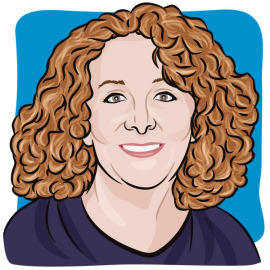- About Us
- Advertise / Support
- Editorial Board
- Contact Us
- CancerNetwork.com
- TargetedOnc.com
- OncLive.com
- OncNursingNews.com
- Terms & Conditions
- Privacy
- Do Not Sell My Information
- Washington My Health My Data
© 2025 MJH Life Sciences™ and CURE - Oncology & Cancer News for Patients & Caregivers. All rights reserved.
Teaching, Writing, Healing: The Intersections of My Cancer Journey

F. Linda Cohen, from Baltimore, now lives in Franklin, Michigan. She attended UMBC and attained her Masters’ Degree from Oakland University, Rochester, Michigan. Linda, a retired reading specialist, with a specialty in dyslexia, published a book documenting her parents’ story in February, 2019. Cohen’s book, "Sarinka: A Sephardic Holocaust Journey From Yugoslavia to an Internment Camp in America," is currently in the libraries of the United States Holocaust Memorial Museum in Washington D.C. , Yad Vashem Holocaust Museum in Israel, the Zekelman Holocaust Memorial Center and other community and school libraries.
Fifteen years after being diagnosed with small lymphocytic lymphoma, I’ve found healing and meaning in the work I love and the life I’m grateful to live.
When I was first diagnosed with small lymphocytic lymphoma 15 years ago, I was told it was an indolent disease — with no cure. I was 57 years old at the time. First, I had to look up indolent to understand exactly what it meant medically. (Did I mention I was a teacher? I needed the precise definition!) “In a medical context, indolent describes a condition that is slow to develop, inactive, or relatively benign, often associated with little or no pain. It’s commonly used to describe certain types of cancers, such as lymphomas, where the disease progresses slowly. Indolent conditions are characterized by slow growth or development, in contrast to aggressive conditions that progress rapidly.”
But I don’t think I initially processed the part I was told about no cure. Okay, I thought. It could be so much worse. Over the years, I’ve learned to reframe the challenges life throws my way. At least I would have some time with this new life companion — cancer. Thank God it’s not aggressive, and maybe I won’t need treatment right away. Of course, I was shocked. I was trying to process this new reality. It’s much easier to talk about it 15 years later than it was on the day I got the news. At the time, I had just retired from a job I loved — as a reading specialist. I planned to tutor a few hours a week so I could be more available to help care for my aging mother.
With this new normal, I knew I needed to keep tutoring to stay grounded and not dwell too much on the diagnosis. I never shared the news with my mother. She was a Holocaust survivor. My father had passed away. They had been married for 60 years. She simply could not have handled it. So I threw myself into my work — tutoring reading and writing — and into publishing a book about my parents’ survival, titled Sarinka. I also began keeping a 10-year journal. I wanted to document this chapter of my life — not for anyone else, just for myself.
You can see a photo of the journal at the end of this blog. I think you need to physically see it so the idea doesn’t feel overwhelming… even thinking about a 10-year journal!
My family was incredibly supportive. They noticed how completely I poured myself into teaching and writing. I think they understood that those things were keeping me afloat. I became deeply determined to finish and publish Sarinka. I was afraid I might not live to see it in print, and it was a story that needed to be told.
Over the past 15 years, I’ve needed three different infusion treatments, radiation, regular antibody infusions to support my immune system, and now a BTK inhibitor (Acalabrutinib), which I may be coming off of soon. I was told it will come back, but I can go off of it for maybe a few years. But you know what? I’m living a quality life — something I never imagined I’d be able to say when I was first diagnosed.
Teaching, writing and healing have intersected in ways I could never have foreseen. They’ve given me purpose and peace. They’ve helped me stay focused not on illness, but on life. I walk daily with my husband. I laugh, get silly with my grandchildren, whom I’m so lucky to have now, and I remain deeply grateful for this time I’ve been given.
For more news on cancer updates, research and education, don’t forget to subscribe to CURE®’s newsletters here.
Related Content:



